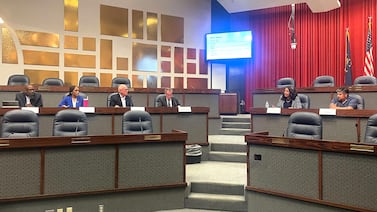Sign up for Chalkbeat Detroit’s free newsletter to keep up with the city’s public school system and Michigan education policy.
The state budget Gov. Gretchen Whitmer signed this week included transparency requirements — one would give parents more insight into what reading curriculum their school uses — and a new rule to bar schools from using financial incentives to encourage students to attend school on Count Day.
These were among some of the lesser known parts of the budget, with much of the attention going to record levels of per-pupil funding, a big increase in at-risk funding, and the protection of an initiative that provides free breakfasts and lunches to students regardless of income.
The budget also included more money for schools to lower class sizes in the lower grade levels, eliminated flexibility that allowed districts to hold up to 15 days of virtual instruction, and created a new funding source to provide additional pay for teachers.
The budget was approved after months of stalled negotiations, and after the legislature blew two budget adoption deadlines.
Some of the new provisions are puzzling because there was little to no discussion about them, said Robert McCann, executive director of the K-12 Alliance of Michigan, a group that represents the interests of dozens of school districts in the state. He raised concerns that the budget includes new curriculum requirements well over a month into the school year.
“This is just another example of how broken this budget process was,” McCann said.
Here are some details about the budget:
Parents to get a heads up if their child’s school uses a reading curriculum that isn’t recommended
New language in the budget requires districts to notify parents if their schools use a K-5 reading curriculum that isn’t on the state’s list of evidence-based curriculum, or that isn’t aligned with state standards. An evidence-based curriculum is one that research has shown to be effective. As part of that notification, schools must tell parents that the curriculum they’re using “could negatively impact student academic outcomes.”
Whitmer proposed such a transparency measure when she presented her budget proposal earlier this year.
The new requirement comes in the midst of disappointing student performance on state and national exams. On the National Assessment of Educational Progress, known as the Nation’s Report Card, just 24% of Michigan fourth graders were considered proficient, and results overall showed little improvement even as other states showed gains. On the Michigan Student Test of Educational Progress, performance in many grades and subjects went up slightly, but third graders posted their worst reading scores in the 11-year history of the exam.
In addition to informing parents that the curriculum doesn’t meet state guidelines, school leaders must also let parents know why they’re using a curriculum that isn’t evidence-based and share a plan for when such a curriculum will be adopted.
If schools fail to notify parents, they risk losing up to 5% of their state aid.
No more financial incentives for Count Day
Another way schools can lose up to 5% of their state aid: by offering financial incentives to students to attend on Count Day.
Some schools have offered gift cards or other incentives for students who show up. But it’s unclear how widespread those practices are across the state.
There are two count days in Michigan: One on the first Wednesday in October and another on the first Wednesday in February. Student enrollment counts on those days largely determine how much state aid a school district receives.
And because schools are funded on a per-student basis, getting kids to school has been vitally important on those days. (Schools can still count some students who are absent on Count Day as long as they attend school within a certain time period afterward.) It’s why some enrollment-challenged schools entice students to attend by offering things like pizza parties for the classroom with the highest attendance, extra classroom credits, and fun activities.
Additional funding to lower class sizes
The budget sets aside $65 million, to be paid in grants, to allow school districts to maintain or establish lower class sizes in grades K-3.
School districts with large percentages of students from low-income homes would be eligible to receive the grants.
Class sizes would be capped at 19 students per class.
The budget identifies several school districts (Muskegon Heights Public School Academy System, Benton Harbor Area Schools, Flint School District, and Wayne-Westland
Community School District) to automatically receive these class size grants.
The budget also allows all districts to use up to 30% of their at-risk funding to reduce class sizes.
No more virtual instruction days
The budget eliminates language that allowed school districts to hold up to 15 virtual instruction days.
Michael Rice, who retired Friday as state superintendent, has pushed the legislature to remove that language, as well as flexibility that allows up to seven professional development days to count as instructional days. During professional development days, teachers spend the day training, and students stay home and receive no instruction.
The virtual hours provision was struck, but schools can continue to count the professional development days as instructional days.
New teacher pay fund
The budget includes $350 million in one-time grants to increase educator compensation, though details are still scarce about how the money can be spent.
Districts must report to parents on how at-risk grant money is spent
The budget increases funding for at-risk students by 25%, but it also adds a new reporting requirement for school districts.
Districts receiving the at-risk money must now provide a report to parents that shows how much funding they received, how the money was distributed, and what evidence-based interventions were used with the funding.
Districts must also provide a method for which parents can provide feedback on how the money is used.
Lori Higgins is the bureau chief for Chalkbeat Detroit. You can reach her at lhiggins@chalkbeat.org






